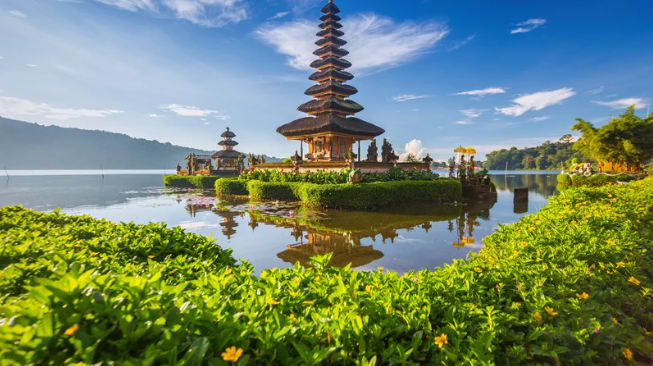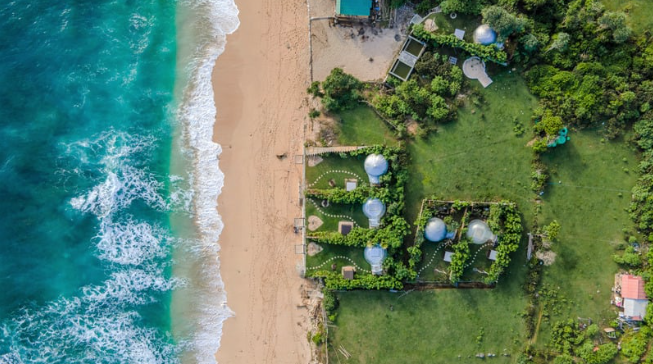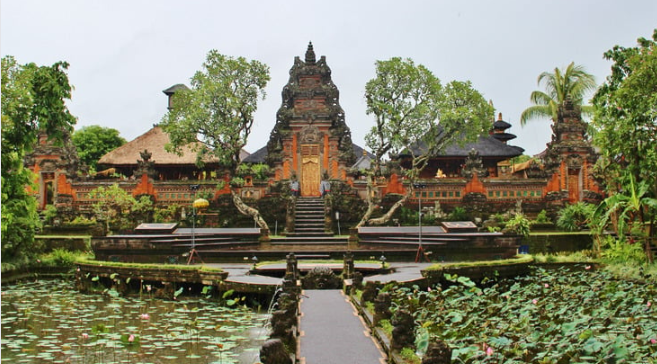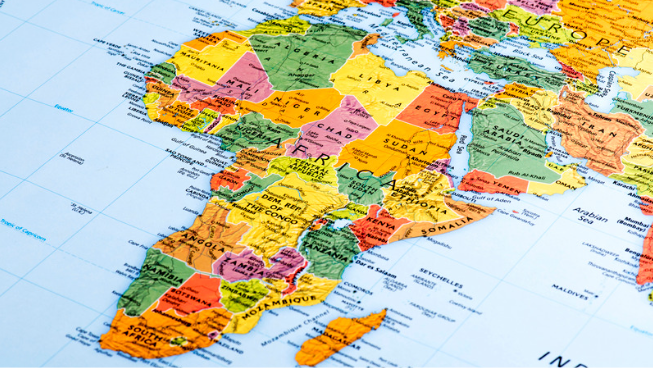What Continent Is Bali In
To uncover the mystery of Bali’s location continent wise, explore this section with subsections including an introduction to Bali and its location along with understanding the continental position. Delve into the details to understand the unique geographical location of Bali and gain a deeper appreciation for its hidden treasures.
Introduction To Bali And Its Location
The Continental Mystery of Bali Unveiled!
Bali, or the Island of the Gods, is an Indonesian island located in Southeast Asia. Many travelers and geologists have been puzzled by its location. It’s east of Java and west of Lombok Island, and part of the Lesser Sunda Islands, or Nusa Tenggara.
Bali lies on the equator, giving it a tropical climate with two main seasons: rainy season (October-March) and dry season (April-September). Indonesia’s largest airport, Denpasar International Airport, is in the south of Bali.
But, that’s not all! Bali is also part of the famous “Ring of Fire.” This is where several tectonic plates converge, creating spectacular landscapes and exotic volcanic activities. Visitors can explore these hidden natural wonders all over the island.
Ready to go? Check flights on incognito mode for better rates. And don’t forget to bring hygiene essentials to keep up with pandemic precautions.
Why not declare Bali its own continent instead?
Understanding Bali’s Continental Position
Unravel the mystery of Bali’s continental position! For a long, geographers have been intrigued by its exact location. It’s essential to know where Bali lies to appreciate its unique features and history.
Bali is an island situated in the southern Hemisphere, bordered by the Indian Ocean to the south and the Java sea to the north. Three tectonic plates – Indo-Australian Plate, Eurasian Plate and Pacific plate – meet here. As a result, Bali has volcanic soil rich in minerals and favorable weather for agriculture.
Surprisingly, Bali belongs to Indonesia’s Lesser Sunda Islands, not Australia or Asia as many would assume. This makes Bali vulnerable to natural disasters like earthquakes and tsunamis.
To explore the culture of Bali, tourists should go beyond beaches and take a look at local customs associated with agriculture, crafts, and temples. Also, travelers can help conserve the environment by volunteering in activities like beach clean-ups or sustainable farming projects.
Understanding Bali’s continental position will help visitors appreciate its ecosystems’ fragility and contribute to conservation efforts through responsible tourism. So, why settle for boring geography lessons when you can experience the beauty and volcanic landscape of Bali?
The Geographical Features of Bali
To understand the geographical features of Bali, the island’s terrain, climate and fauna play an important role. In order to explore this hidden gem, have a look at Bali’s continent: uncovering its hidden treasures. The subsections will briefly delve into the island’s terrain and topography, Bali’s climate and weather patterns, and the flora and fauna of Bali, providing unique insights into what makes this destination one of a kind.
The Island’s Terrain And Topography
Pack your sunscreen and raincoat – Bali’s weather keeps things unpredictable. The Island is majestic, boasting diverse terrain, topography and geology. Its landscape is stunning – volcanic mountains, lush green rice fields and magnificent beaches. Mount Agung is the highest peak, soaring 3,031 meters high. There are two other active volcanoes – Mount Batur and Mount Bratan, with craters and calderas offering an awe-inspiring view.
The north of the Island is full of thick forests, while the south is lined with miles of sandy beaches. The central region has a unique mix of mountains and verdant rice terraces. The Ayung River is renowned for white-water rafting.
Bali’s geological features have had a big impact on its culture and economy. The fertile volcanic soil is used to cultivate rice, coffee, cacao and spices. Balinese Hinduism centres around offerings made in natural settings, such as rivers and mountains.
An ancient fable tells of a wicked giant named Kebo Iwa who stole the gods’ abundant blessings and hid them under 500 rivers across Indonesia. He did this when he felt a threat on his position after using those blessings to overtake the kingdom of Sanskrit where he was employed as a royal lifter (Maihofer & Wibawa). But Bali’s beautiful volcanoes, forests and hills are blessings enough for the culture and economy we have today.
Bali’s Climate And Weather Patterns
Bali boasts a tropical monsoon climate, with wet and dry seasons. From November to March, heavy rain soaks the island, while the dry season starts in April and ends in October. Year-round, temps hover around 27°C.
The wet season is humid and often brings storms. Low-lying areas can flood, disrupting transportation and tourism activities. The dry season is most popular for tourism, with clear skies and sunny weather.
In addition to seasonal changes, Bali’s climate is also influenced by its microclimates. Southern regions are arid, due to Mount Agung’s rain shadow region. And higher-elevation regions like Bedugul are cooler than coastal spots.
Pro Tip: Check the weather forecast before planning a trip. Pack accordingly for fluctuating weather! Plus, watch out for monkeys – they may steal your food and your heart.

Fauna And Flora Of Bali
Bali is full of diverse plants and animals, making it a top biodiverse island in Indonesia.
A table of Bali’s flora and fauna could include:
| Flora | Fauna |
| Bali Starling | Javan Rusa Deer |
| Frangipani Tree | Giant Komodo Dragon |
| Cempaka Flower | Black Giant Squirrels |
| Coconut Palm | Java Sparrows |
| Chocolate Frogs |
Plus, Black Giant Squirrels, Java Sparrows, and Chocolate Frogs are some of the other unique species that contribute to the island’s biodiversity.
For those interested in discovering Bali’s wildlife, visiting nature reserves or national parks is a must. Apart from that, Bali also offers amazing beaches and a great cultural and historical heritage.
Bali’s Cultural and Historical Heritage
To uncover Bali’s hidden treasures and learn about its rich cultural and historical heritage, explore the section on ‘Bali’s Cultural and Historical Heritage’ in ‘Bali’s Continent’ article. Discover the uniqueness of the Balinese culture and its customs along with the historical influence and legacy Bali has had over the years. Additionally, explore the ancient temples and monuments in Bali to gain insight into its rich history and spirituality.
The Balinese Culture And Its Uniqueness
Discover the unique culture of Bali – a mix of Hindu, Javanese, and indigenous traditions. It’s more than just the stunning beaches – it is filled with religious practices, art, music, and dance that embody the spirit of living. From its colorful architecture to daily offerings, its cultural heritage shines through.
One such example is the spellbinding Kecak dance. Male performers chant in sequences resembling a monkey’s chatter. Its dramatic nature captivates all who watch. Also, the traditional Gamelan orchestras are made up of indigenous instruments like drums, xylophones, and gongs.
Customs are essential to Balinese life. Before entering a house or temple, visitors must ask permission. Any disrespect towards their people or culture can lead to outrage.
Experience the local culinary delights – from pork skewers to rich, spicy Nasi Goreng. Tourists can also marvel at thousands of shrines filled with remarkable decorations and gifted artisans hard at work.
In short, Bali offers travelers an opportunity to witness unique features that can’t be found anywhere else. When they observe different ways of life, it’s a reminder of our diversity – diversity at its best! Bali may have some dark moments, but it’s not as controversial as the legacy of some colonial powers.
Bali’s Historical Influence And Legacy
Bali’s cultural and historical influence on the world is immense. Ancient architecture, unique customs and an indelible mark on humanity all stem from the Austronesian people’s 4,000 year old migration from China, Taiwan and Southeast Asia. They brought their customs, religion, language and arts.
Bali’s past is full of conflict and conquest, with spiritual practices such as Hindu-Buddhist beliefs dominating. There are hundreds of temples, built during Southeast Asia’s Hinduism period. Colonization by European powers also shaped Bali’s current form.
The island’s art scene is extraordinary. Sculptures, paintings, weaving and shadow puppetry are just some examples of traditional Balinese artistry. Batik is popular, where wax is used to produce intricate designs on fabrics.
The stories of Bali show off its vibrant culture and heritage. For instance, the Tirta Empul water temple is a powerful legend. Thousands of people visit it each year, hoping for purification in holy water springs.
To sum up, Bali’s cultural and historical legacy has a huge impact on Indonesia and the rest of the world. Visiting Bali’s ancient temples and monuments is like going back in time – without the awkwardness!
Ancient Temples And Monuments In Bali
Bali dazzles with its plethora of historical and cultural monuments that have withstood the test of time. Explore the iconic Besakih Temple, Goa Gajah Cave, Tirta Empul temple complex, Royal Palace in Ubud, Pura Luhur Batukaru temple complex and Gunung Kawi Sebatu Temple to understand the island’s legacy. Pura Tanah Lot, the popular seaside temple, is a must-visit! Plus, don’t forget to wander through the UNESCO Heritage Site, Tegalalang Rice Terrace.
These sites not only hold religious significance, but also showcase Balinese mythology through their intricate sculptures and carvings. To really make the most out of your experience, remember to:
- Respect local customs when entering sacred grounds.
- Hire an experienced guide.
- Learn some Bahasa phrases.
- Dress appropriately.
Now, let’s explore Bali’s secret paradise – with its breathtaking nature, you’ll forget all about that Bintang singlet you’re wearing!

Bali’s Hidden Natural Wonders
To uncover Bali’s hidden natural wonders with a focus on waterfalls, natural baths, beaches, and oceanic landscapes, volcanoes, and caves, dive into this section. Gain insight into how to experience the best of Bali’s awe-inspiring nature through these sub-sections.
Waterfalls and Natural Baths
Unearth Bali’s secret natural wonders! From mesmerizing waterfalls to secluded baths, the island is brimming with opportunities to explore its incredible beauty. Immerse yourself in a realm of magnificent nature and invigorating waters, creating memories to last a lifetime amidst stunning landscapes. Whether you’re an adventure enthusiast or a relaxation lover, Bali’s waterfalls and baths are the perfect pick-me-up!
Feel the refreshing breeze while you hike through lush forests leading to majestic cascading waterfalls. Take a dip in cool pools with vivid greens and blues, giving your mind and body a boost. Step back and take in the tranquil atmosphere, hearing the birds singing and streams trickling – you’re in another world!
Curious explorers will adore uncovering hidden gems like Sambangan Secret Garden and Tegenungan Waterfall near Ubud. Thrill seekers may even try waterfall rappelling at Gitgit Waterfall. For a more intimate experience, away from the crowds, visit Les Waterfall or Tibumana Waterfall.
As you traverse Bali’s natural wonders, remember their historical importance. These waterfalls have been essential to Bali’s agriculture, supplying irrigation systems for rice paddies, which still support Balinese communities today. It’s remarkable how these gorgeous sights have both visual appeal and practical use throughout history.
Ready for beach bum life in Bali? Sun, sand, and sea await you with open arms!
Bali’s Beaches And Oceanic Landscape
Bali is a paradise of tropical beaches and a vast oceanic landscape that will take your breath away. Sun-seekers will love its sandy coastlines, perfect for surfing and snorkeling. Below the vibrant blue waters, coral reefs are home to a variety of marine creatures, while shipwrecks are great for diving.
But the beaches are only the start. Behold the Git Git waterfall – a 40-meter tall cascade nestled between lush rainforests. Unwind and find peace amidst the hustle and bustle of the city.
Also, don’t forget the Balinese long-tailed macaque – the island’s signature animal. These playful creatures can be spotted in the Ubud monkey forest.
Don’t miss out on this chance to explore Bali’s hidden gems. Plan your trip today and soak up some breathtaking sights! And, if you’re feeling adventurous, try the volcanic caves – just don’t bring snacks… they’re hot enough to cook an egg!
Exploring Bali’s Volcanoes And Caves
Discover the rugged beauty of Bali’s natural landscape! Climb volcanoes, hike up to breathtaking peaks and descend into underground limestone caves. Uncover hidden gems and ancient secrets from centuries past.
Visit Goa Gajah and explore the mystical Goa Lawah Temple, guarded by thousands of bats. Mount Batur is part of a UNESCO Global Geopark network and is one of Bali’s most-visited spots. Learn about the history of Mount Agung’s 1963-64 eruption, where locals witnessed one of history’s largest recorded volcanic events.
Spice up your taste buds with Bali’s traditional cuisine for a mini tropical vacation on your plate!
Bali’s Traditional Cuisine
To understand Bali’s Traditional Cuisine with an emphasis on Introduction to Balinese traditional dishes, The Ingredients that make Balinese Cuisine and Popular Balinese dishes to try. This section will offer you an insight into the famous Balinese dishes that have been passed down for generations, the ingredients that make Balinese cuisine unique and the must-try dishes when you are in Bali.
Introduction To Balinese Traditional Dishes
Balinese cuisine is a mix of intriguing spices, flavors, and textures that can tantalize a food lover’s taste buds. This island of gods offers an array of delicious traditional dishes that show off vivid colors, unique tastes, and textures.
Rice has a special role in Balinese culture and religion, so it’s the main ingredient in traditional dishes. Sambals are condiments made with chilies, lime juice, shallots, and other spices.
Babi guling (roast pig), lawar (meat or vegetables with coconut and spices), and bebek betutu (smoked duck) are popular dishes. Other well-known meals include nasi campur (rice with a mix of vegetables, meat, and eggs), mie goreng (stir-fried noodles), and ayam betutu (spiced chicken wrapped in banana leaves).
Vegetarian dishes, such as jukut urab (vegetables mixed with grated coconut) and tempeh-based recipes, add to the variety of Balinese traditional cuisine.
Pro Tip: Don’t forget to top off your feast with ‘Brem,’ a traditional fermented drink made from rice. Balinese cuisine – where the ingredients are as exotic as the flavors they create!
The Ingredients That Make Balinese Cuisine
Taste The Distinctive Flavors Of Balinese Cuisine!
Check out the core components that make Balinese cuisine unique. The table includes:
- Mains
- Sides/Vegetables
- Spices/Seasonings
Think Babi Guling (roasted suckling pig), green papaya salad and shrimp paste (Satay Lilit is a must-try Balinese main dish). Plus, they use indigenous vegetables too! Sample different dishes at local restaurants, starting mild before getting spicier. Experience a taste of heaven and maybe a bit of hell with Balinese dishes.
Popular Balinese Dishes To Try
Taste Bali’s traditional cuisine! A trip to the island is incomplete without savoring its unique delicacies. Try Nasi Goreng – fried rice dish spiced up with chicken or prawns and veggies. Or Satay – grilled meat skewers served with peanut sauce. Don’t forget the Balinese-style Babi Guling – a roasted pig stuffed with spices and herbs.
Explore Bebek Betutu – duck cooked in banana leaves and flavored with garlic, ginger and chili. Check out Warung Teges for a Balinese-style breakfast. The menu includes Nasi Jinggo – steamed rice packed in banana leaf with shredded chicken or fish.
Traditionally, Balinese people cooked at home. But commercialization changed the food scene, leading to more experimentation with exotic flavors. Try traditional Balinese dishes to savor their culture’s taste buds while exploring the majestic island. And why stick to tradition when you can spice things up with Bali’s contemporary attractions and activities?

Bali’s Contemporary Attractions and Activities
To uncover the contemporary attractions and activities of Bali, focus on art, culture, adrenaline-fueled adventures, dining, and nightlife. Performing arts and museums showcase the rich cultural heritage of Bali, while surfing and paragliding provide adrenaline rushes. Dining and nightlife offer a variety of experiences, from traditional Balinese cuisine to international flavors and lively bars and clubs.
Art and Culture: Performing Arts and Museums
Art and culture have always been a major part of Bali’s heritage. From traditional dances to museums, it has a lot to offer in the world of performing arts and culture.
- Witnessing Barong dance or Kecak dance is a must-do while you’re there.
- Visit the Agung Rai Museum of Art (ARMA) and the Neka Art Museum to get a glimpse of Balinese paintings, sculptures and more.
- Go to Ubud’s Museum Puri Lukisan for traditional art, Western-influenced artworks, and modern installations.
- Don’t miss the Ubud Writers and Readers Festival – it showcases literary works by local and international writers.
Apart from these, visitors can also see unique exhibitions by contemporary artists throughout Bali. According to a 2019 UNESCO survey, Indonesia is third in cultural tourism activities.
Surf and paraglide in Bali for an ultimate thrill – because staying on the ground is overrated!
Adrenaline-Fueled Adventures: Surfing and Paragliding
Experience Bali in a whole new way! Try thrilling sports like surfing and paragliding.
Surfing:
- This paradise island offers perfect waves all year round.
- Uluwatu beach is known for its challenging waves, perfect for experienced surfers.
- Uluwatu beach is also the perfect spot to watch mesmerizing sunsets after surfing.
Paragliding:
- Soar over world-class beaches such as Nusa Dua and beyond.
- Enjoy breathtaking aerial views.
- Tandem paragliding experiences are ideal for beginners or those wanting some company.
Combine surfing and paragliding for more excitement! Don’t miss out on these heart-stopping activities!
Did you know?
- Bali is one of the best destinations worldwide for water sports!
- Bali’s dining and nightlife scene will leave you with more than just memories.
Dining and Nightlife in Bali
For a unique experience, explore Bali’s culinary and night-time scenes. Its lush surroundings and vibrant nightlife offer plenty of wining and dining options. From gourmet restaurants to street-side eateries and bars, the island has it all.
Here are five must-do activities for anyone visiting Bali:
- Taste Indonesian cuisine at Warung Made.
- Visit Mama San for an Asian-inspired meal.
- Enjoy European delicacies at Kilo Lounge.
- Head to La Favela for lively bar-hopping.
- Groove at the iconic Potato Head Beach Club.
For a night full of entertainment, Bali offers a diverse mix. Try epic pool parties at Finn’s Beach Club, or experience a cultural performance over dinner at Café Wayan.
Bali also has progressive eateries, such as Locavore, which offer immersive dining experiences with locally-sourced produce.
Don’t forget the tales of nightlife! From A-listers’ secret hideaways to local hangouts, there’s something special everywhere. For instance, a group of travelers once stumbled upon Old Man’s Bar and had such a great time they didn’t leave until morning!
Bali is a paradise of exotic beaches, ancient temples, and modern attractions that will keep you having more fun than a monkey stealing your fruit.
Conclusion: Bali As A Destination Worth Exploring
Bali’s mystery draws you in. It’s a captivating getaway. Vibrant culture, stunning beaches, and delicious food. Take in the rolling rice paddies and lush forests. Find hidden waterfalls and treks through the hills. Shop for colorful handicrafts and local produce.
Uncover Balinese culture and temples of art and architecture. They tell tales of centuries past. From the Majapahit Kingdom, learn of royal families and their struggles. See it all in the intricate statues across the island.



